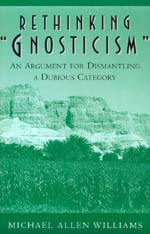 (Reprinted with permission from the journal Church History, written by David Brakke.)
(Reprinted with permission from the journal Church History, written by David Brakke.)
Rare is the book on “gnosticism” that is thoroughly grounded in the primary sources in the ancient languages, widely conversant with the secondary literature, controlled and sophisticated in its historical method—and still intelligible and interesting, not only for experts in its field, but also for religious historians and educated readers in general. Michael Williams’s Rethinking “Gnosticism”: An Argument for Dismantling a Dubious Category is such a book. It is essential reading for scholars of ancient Christianity and for anyone who wishes to use the terms “gnostic” and “gnosticism,” but it can be read with profit by all historians concerned with issues of methodology in studying religious people of the past.
Williams presents a devastating critique of the scholarly construct “gnosticism,” a term apparently invented in the seventeenth century and in search of an adequate referent or definition ever since. The author first mentions four persons or documents that scholars usually have called gnostic—the Apocryphon of John, Ptolemy the Valentinian, Justin’s Baruch, and Marcion of Sinope. Williams then exposes the problems with the current modes of defining gnosticism and proposes that the category be abandoned in favor of both more particular traditional or sociohistorical designations such as “Valentinianism” and a broader category, “biblical demiurgical traditions.” The latter would include “all those that ascribe the creation and management of the cosmos to some lower entity or entities, distinct from the highest God,” as they “also incorporate or adapt traditions from Jewish or Christian Scripture.” This category “would include a large percentage of the sources that today are usually called “‘gnostic.’”
With detailed but clear analyses of the ancient writings, Williams persuasively makes the following claims. Gnostic biblical interpretation was neither “protest exegesis” nor a thoroughgoing reversal of biblical values, but a series of attempts—similar to other such among the ancients—to solve problems in the biblical text (such as disturbing actions by God). The gnostics were not alien parasites feeding off vibrant, independent religions, but dynamic and intelligent innovators within their traditions. They were most likely not rejecting the world out of some anticosmic attitude but attempting to reduce the tension between their biblical traditions and the surrounding Platonizing culture. Gnostic writings exhibit a range of attitudes toward the body that cannot be reduced to “hatred.” Far from exhibiting the extremes of either asceticism or libertinism, gnostic ethics conformed to the general ascetic tendencies of the day, but also made room for the concept of the family.
Williams examines theories surrounding the production and ancient use of the Nag Hammadi codices. He considers it most likely that the scribes were fourth-century Egyptian monks interested in demiurgical and cosmic speculation and in the transcendence of the soul, and he offers possible rationales for the selection and arrangement of the treatises in each codex. The needs and concerns of these later compilers, however, must not be confused with those of the original authors.
Throughout the book Williams cogently shows the variety of perspectives within gnostic literature and their moderate—rather than radical—character within their late ancient milieu. He also makes judicious and fruitful use of sociological models for religious movements developed by Rodney Stark, his colleague at the University of Washington, and William Sims Bainbridge.
It is refreshing to find a scholar studying these materials in a manner that would appear familiar and illuminating, rather than strange and irrelevant, to scholars of other phases of Christian history or of other religions entirely.


























